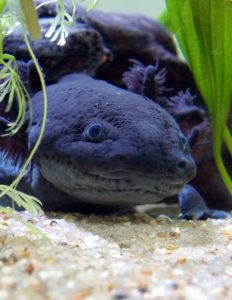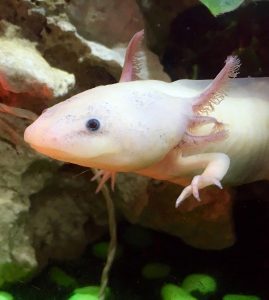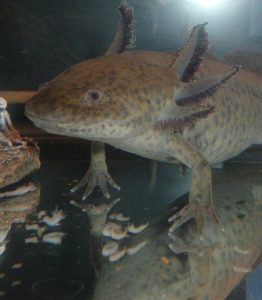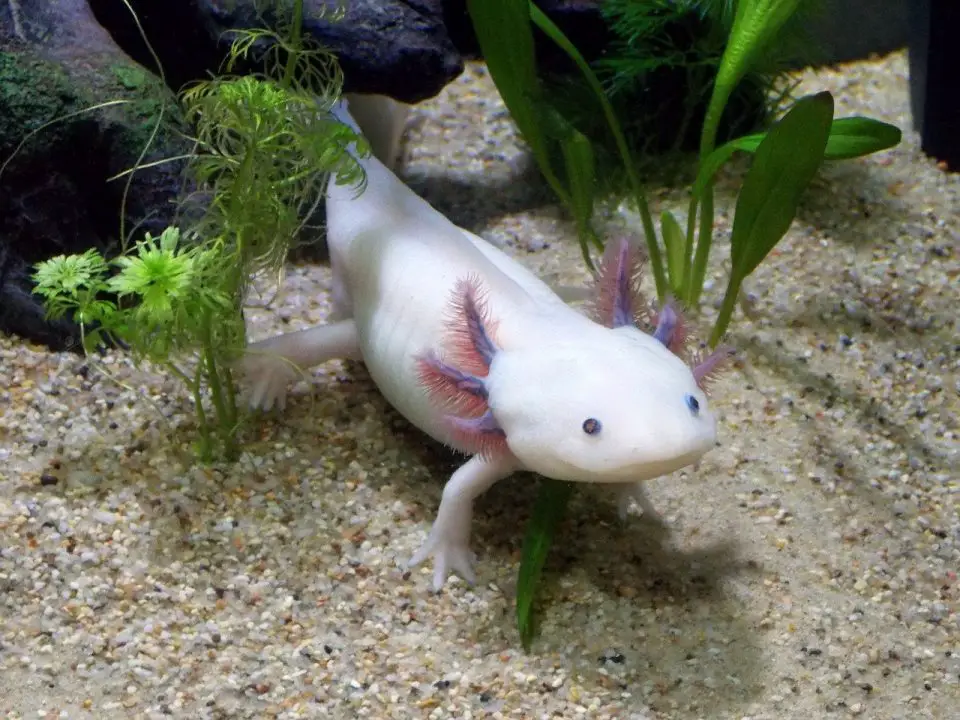Hi, my name’s Irena and I live on Crete in Greece with my fantastic, hyperactive and loving dog, Sherlock and three cats who are called Hamlet, Dimitris, and Ebony.
Dimitris and Ebony do not like Hamlet, and I have no idea why. Today I’m going to tell you all about Axolotl colors and believe me, there are plenty of amazing colors.
What are Axolotls?
Perhaps you’ve never heard of Axolotls. It wouldn’t be surprising as they’re not very common pets. However, they are definitely unique and make a great display pet.
They are types of salamanders, but unlike ordinary salamanders, they don’t undergo metamorphosis from larval to adults.
This means that they stay aquatic for their whole lives and shouldn’t be removed from their tank. Interestingly, they have the special skill of being able to regenerate their limbs.
Axolotls are originally from Xochimilco Lake in Mexico. They are considered to be an endangered species in the wild, but they have been bred in captivity, so all is not lost for them.
They have also been bred in a variety of colors, so they aren’t all like the wild Axolotls which are dark and very similar in color.
Most Axolotls reach a length of about 10 inches. A few have grown up to 12 inches, but they are rare. When they reach 8 inches, they are sexually mature.
This can happen anytime between six months and a year. Axolotls have been known to reach 20 years of age in captivity, but their average life span is 10 years.
What Does an Axolotl Need From its Tank?
They are hardy creatures and are relatively tame. You should provide them with a big tank since they spend all their lives underwater.
A 10-gallon tank or aquarium is adequate for one Axolotl, but they do produce a lot of waste matter, so a 20-gallon tank is much better.
You need to have a lid on the aquarium as they can jump out which will kill them. A filter is needed, but make sure it is low flow.
If the water is too wavy, Axolotls can develop stress and go off their food. They don’t need lighting, especially not bright lights as it can be detrimental to their health.
They need to be kept in water temperatures of between 60 and 64F. Any lower and they become sluggish and temperatures above 74F can kill them. If you live in a warm area you can buy an aquarium chiller.
The ideal substrate for Axolotls is sand. If you put in gravel, they tend to eat it which could kill them.
Axolotl Food
The best foods to give them are earthworms, frozen blood cubes, frozen cooked shrimp, and lean pieces of beef and chicken. Don’t feed them live fish as they can cause parasites and disease.
Axolotls are soft-bodied and shouldn’t be handled unless it’s absolutely necessary. They aren’t very social with other Axolotls, so they don’t need a companion.
Fights could even break out if there are two Axolotls in the tank. Young Axolotls tend to bite off feet and gills. They should only be put together for mating purposes.
If you do buy both a male and a female, you will have to buy separate tanks for a normal life.
Why does an Axolotl Come in Such a Variety of Colors?
 The variety of Axolotl colors is all due to genetics. Each of them has 28 chromosomes, 14 from the mother and 14 from the father.
The variety of Axolotl colors is all due to genetics. Each of them has 28 chromosomes, 14 from the mother and 14 from the father.
There are three types of pigment cells that Axolotls have which determine what colors they will be.
The first is melanophores. They contain eumelanin which makes their color brown or black.
The second is xanthophores which contain carotenoids and pteridines and give red and yellow pigmentation.
The last is iridophores which contain crystalized purines that give an iridescent pigmentation.
Experienced breeders can create amazingly different colors and we are going to take a look at them here.
Basic Axolotl Colors
Wild Color
Wild Color Axolotls are what you will find at Xochimilco Lake, but you can also have this color at home. They are the most common color and are a combination of olive, gray, green and black colors.
When they are born, they are very dark, sometimes completely black, but as they age, they become much lighter.
They have golden and iridescent speckles around their bodies which makes them look a little glittery.
Their gills are either gray or purple. What is particularly interesting about them is their eyes. They have a black center, but there is a golden or shiny ring around this.
Leucistic
Leucistic Axolotls are among the most attractive Axolotls you can get. An alternative name for them is the Pink Axolotl and this is because they are either very light in color or even pink.
Their gills can either be a deep pink color or dark red and they can even have freckles.
Their eyes are dark brown or black, which differentiates them from the White Albino Axolotls who have clear eyes with red centers.
White Albino
The White Albino comes in two forms known as the White Axolotl and the Axanthic Axolotl. White Albinos have iridophores, which is the shiny pigment in their eyes and gills.
Their gills look pink, but that is just because you can see the blood flowing through them.
Axanthic Albinos don’t have iridophores and nor do they have xanthophores, which is the yellow and red pigment, nor do they have the black pigment, melanophores.
They are very similar to Leucistic Axolotls. Their bodies are white, but their gills are a deep red. Unlike Leucistics however, they can’t develop freckles.
Also, they can have dark fingertips when they are developing sexually. Their eyes are clear with red centers. You can also find Albino Melanoids.
Combining albinism with melanism removes all types of pigmentation except for xanthophores along the back.
Melanoid
Melanoid Axolotls are quite similar to the Wild Color and can often be mistaken for them.
However, they are probably even darker than Wild Colors because they have a lot of pigmentation in their skin.
Their bodies are either very dark brown or black, but unlike the Wild Colors, they don’t have any iridescent shining freckles.
This is what puts them apart from Wild Colors. Both their gills and eyes are completely black.
Golden
The last basic color is the Golden Axolotl. These Axolotls also have a form of albinism, but they are more of a golden or peach color.
You will find that there are patches of these colors all over their bodies and there are also shiny freckles.
Their gills are peachy, while their eyes are clear because of their albinism and they never have dark eyes. The eyes can look a little red or yellow.
When they are younger, Golden Axolotls can be a very bright yellow, but this can fade as they get older.
However, some adult Golden Axolotls can be paler than others. Some also have a lot of iridophore pigmentation which means that they will have white, shiny patches over their bodies.
This can be mistaken for fish fungus if you’re not experienced with Axolotls.
Special Axolotl Colors
The GFP or Green Fluorescent Protein
 The Green Fluorescent Protein Axolotl isn’t technically a color as this condition can appear in Axolotls of any color.
The Green Fluorescent Protein Axolotl isn’t technically a color as this condition can appear in Axolotls of any color.
It is a very exciting and attractive mutation that allows the Axolotls to glow a bright green color under a black or UV light.
It is spectacular but remember not to leave them under the light for too long as it can be very disturbing for them.
This gene was introduced as part of cancer research, but it has been passed down through the generations and now is a very special mutation.
The less skin pigmentation the Axolotls have, the brighter they will glow. The Albino is the brightest, while Axolotls like the Melanoid and the Wild Color are the least bright.
Copper
Copper Axolotls are quite rare and can only be found in certain countries like the US, Germany, and Australia. They are a type of Albino Axolotl.
They have very pale copper-colored bodies that are covered in dark copper freckles. Their gills are dark copper. They have red eyes that are darker than those of Albinos and they lay white eggs.
Copper Axolotls don’t have any melanophores, the black pigment so they don’t have any dark patches. They come in three different shades: copper, light copper, and het copper.
Chimera
These are very unusual Axolotls as they get their color when 2 eggs fuse together. This means that one side of the Axolotl is one color and the other, another.
They look as if they are two Axolotls sewn together. Unfortunately, not many of these Axolotls survive as the two sides grow at different rates.
Because it is a freak of nature, these Axolotls can’t be reproduced by breeding. You would be very lucky to find one of these, though if you intend to breed Axolotls you could end up with one.
Mosaic
Mosaic Axolotls are similar to Chimeras except their colors aren’t split down the middle.
They are produced when two cells form during development and they show colors from both cells. For example, part of the Axolotl could look like an Albino Axolotl while the rest is Melanoid.
Colors can be varied depending on the mixture of the Axolotls. They usually have a speckled pattern across the body.
Like Chimeras, they can’t be produced by breeding as they are freaks of nature. Also, most are infertile so don’t expect to be able to breed with them.
Piebald
Piebalds are the most common of the special mutations. They are similar to Leucistics, but their pigmentation goes all the way down their body and sides, not just on their heads.
Sometimes heavily spotted Leucistics are mistaken for Piebalds, but Piebalds are a lot darker and have thicker black spots. Piebald Axolotls, unlike Mosaics and Chimeras, can be bred successfully.
Rare Axolotl Colors
Silver Dalmatian
Silver Dalmatians are beautiful Axolotls. Their color is somewhere between lavender and purple, and they have interesting black specks all over their bodies.
This makes their coloring look similar to Dalmatian dogs.
Enigma
Enigma Axolotls are extremely rare, and you would be extremely lucky to find one of these for sale.
The base of their bodies is pure black, and they have green patterns all over. Their eyes are black.
Firefly
There are only around 12 Firefly Axolotls to be found today. They were created by a man called Lloyd Strol II who used embryonic graphing to create them.
They can come in different colors; for example, they can have a dark body with a light tail or vice versa. There are even a couple which have dark bodies and GFT tails which glow under UV or black light.
Final Thoughts: Axolotl Colors Guide
 As can be seen, there is a wide choice of Axolotl colors to choose from, ranging from dark to pale, with freckles and without and some which even glow in the dark.
As can be seen, there is a wide choice of Axolotl colors to choose from, ranging from dark to pale, with freckles and without and some which even glow in the dark.
You may struggle to get some of the rare ones as they are coveted, but there are still interesting colors out there that you can choose from.
You probably won’t get them from a pet shop as they need to live in certain conditions that pet stores don’t have access to.
However, try to find a good breeder who knows a lot about Axolotls. If you can see the parents, all the better as it will give you a better idea of the coloring they will have when they grow up.
If you like interacting with your pets, you should get a dog or a cat, but if you like to watch your pets Axolotls will be for you.
They make an excellent display pet and can be made the focal point of your room. They will surely be a conversation starter.
